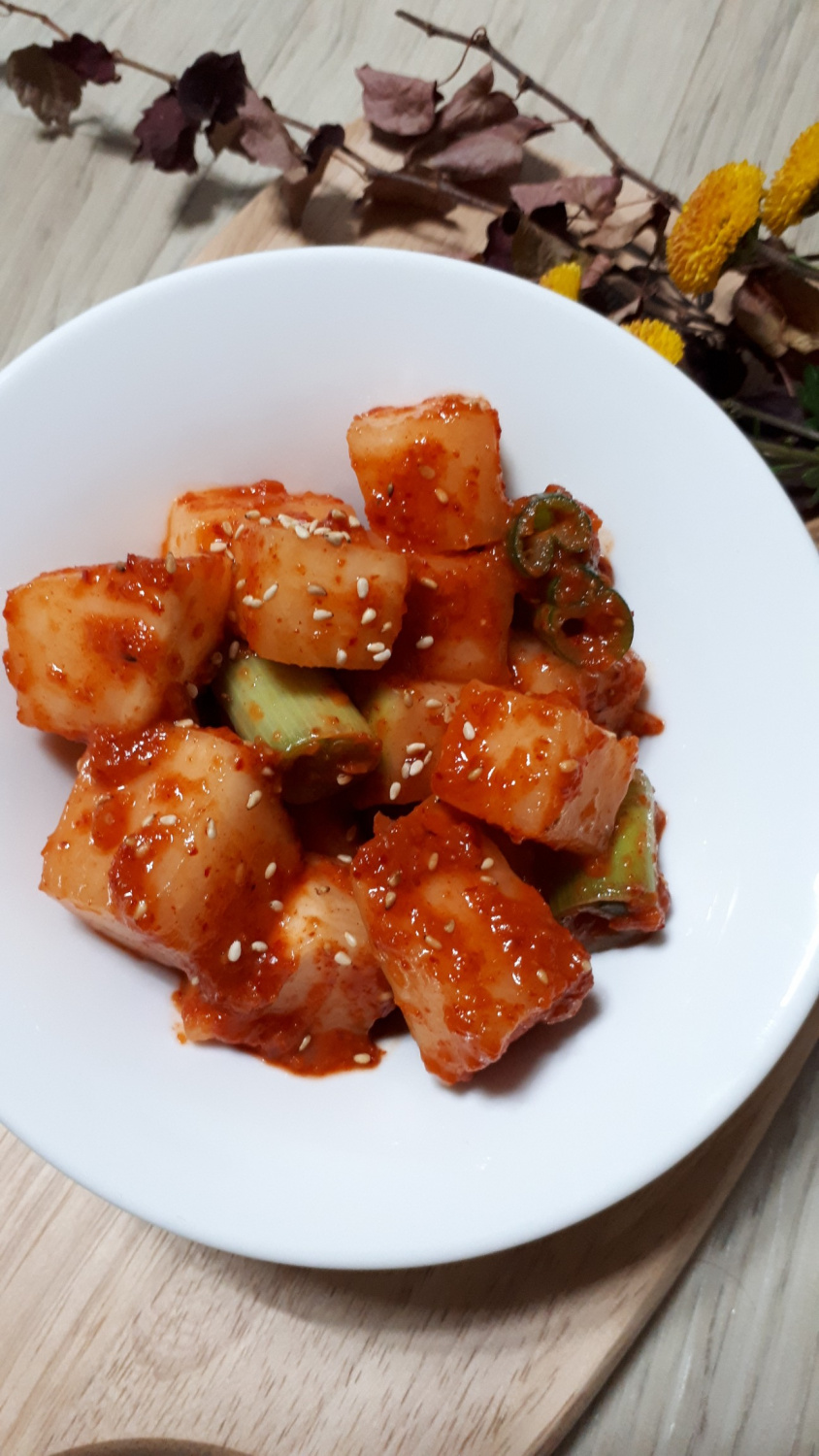Soy Milk Kkakdugi (Cubed Radish Kimchi)
Follow Along: How to Make Kkakdugi (Cubed Radish Kimchi) from ‘Manmulsang’

Winter is the best season for radishes! I decided to try a special Kkakdugi recipe featured on ‘Manmulsang’, which surprised me with its use of soy milk. I was very curious about the taste and texture. Unlike traditional methods, this recipe yields a Kkakdugi that becomes refreshingly tangy and wonderfully crunchy as it ferments. It’s the perfect side dish for hearty meals like beef bone soup or Korean stews. Let’s make it!
Main Ingredients- 5 medium radishes
- 3 green onions
- 2 onions
- 1 pear
- 1 small carton unsweetened soy milk (about 1 cup)
Seasoning Ingredients- 4 cups gochugaru (Korean chili flakes, using paper cup measure)
- 1 cup corn syrup (or oligodang, using paper cup measure)
- 1 cup coarse sea salt (using paper cup measure)
- 2 Tbsp flour
- 4 Tbsp fish sauce (anchovy)
- 3 Tbsp salted shrimp
- 2 Tbsp sesame seeds
- 3 Tbsp minced garlic
- 1 Tbsp ginger powder
- 1 Tbsp sugar
- 4 cups gochugaru (Korean chili flakes, using paper cup measure)
- 1 cup corn syrup (or oligodang, using paper cup measure)
- 1 cup coarse sea salt (using paper cup measure)
- 2 Tbsp flour
- 4 Tbsp fish sauce (anchovy)
- 3 Tbsp salted shrimp
- 2 Tbsp sesame seeds
- 3 Tbsp minced garlic
- 1 Tbsp ginger powder
- 1 Tbsp sugar
Cooking Instructions
Step 1
First, prepare 5 medium-sized radishes. Wash them thoroughly and then cut them into thick cubes, about 3-4 cm in size. Cutting them too thinly will prevent them from retaining their crispness.

Step 2
Cut the radishes into pieces suitable for Kkakdugi. Slightly larger than bite-sized pieces offer a more satisfying chew. Feel free to adjust the size according to your preference; I prefer them a bit larger for a substantial bite.

Step 3
Now it’s time to salt the radishes. Prepare 1 cup of coarse sea salt and 1 cup of corn syrup (or oligodang).

Step 4
Place the cut radishes in a large bowl and mix them well with the prepared coarse sea salt and corn syrup. Let them brine for about 2 hours. If your radish pieces are smaller, you can reduce the brining time. Continue brining until the radishes soften and become slightly translucent.

Step 5
Cut the green onions into large pieces, similar in size to the radish cubes. If they are cut too small, they may become mushy when cooked. Aim for a size that’s pleasant to eat.

Step 6
Peel the onions and pear, then cut them into appropriate sizes. Place them in a blender with the fish sauce and blend until smooth. Adding minced garlic and ginger powder at this stage will enhance the flavor of the paste.

Step 7
Transfer the blended mixture to a large bowl. Add the gochugaru (chili flakes) and mix thoroughly until there are no lumps. It’s important to ensure the chili flakes are evenly distributed throughout the seasoning base.

Step 8
To the seasoning base, add 3 Tbsp of salted shrimp and 1 Tbsp of sugar. (If you dislike the appearance of whole salted shrimp, you can use clear salted shrimp paste or fish sauce.) Mix these ingredients well to complete the seasoning paste.

Step 9
Drain the brined radishes, but do not rinse them. Keep any accumulated liquid. Rinsing would remove the salt that helps tenderize the radish while keeping it crisp.

Step 10
Add 2 Tbsp of flour to the drained radishes and gently toss them. The flour will act as a binder, helping the seasoning adhere better. (The original recipe mentioned 3 Tbsp, but 2 Tbsp is usually sufficient.)

Step 11
Add the chopped green onions and the prepared seasoning paste to the flour-coated radishes.

Step 12
The TV show suggested 1 cup of soy milk, but mentioned it could be substituted with other soy milk. I used a carton of unsweetened ‘Jin Kong Soy Milk’. Using soy milk adds a subtle richness and smoothness to the Kkakdugi.

Step 13
Add the 1 cup of soy milk (or prepared from step 11) and 2 Tbsp of sesame seeds to the mixture.

Step 14
Put on food-safe gloves and mix all the ingredients thoroughly. Ensure the seasoning is evenly distributed and coats every piece of radish.

Step 15
Pack the well-mixed Kkakdugi into a kimchi container. Let it ferment at room temperature for 1-2 days, then store it in the refrigerator. Enjoy your delicious homemade Kkakdugi!



